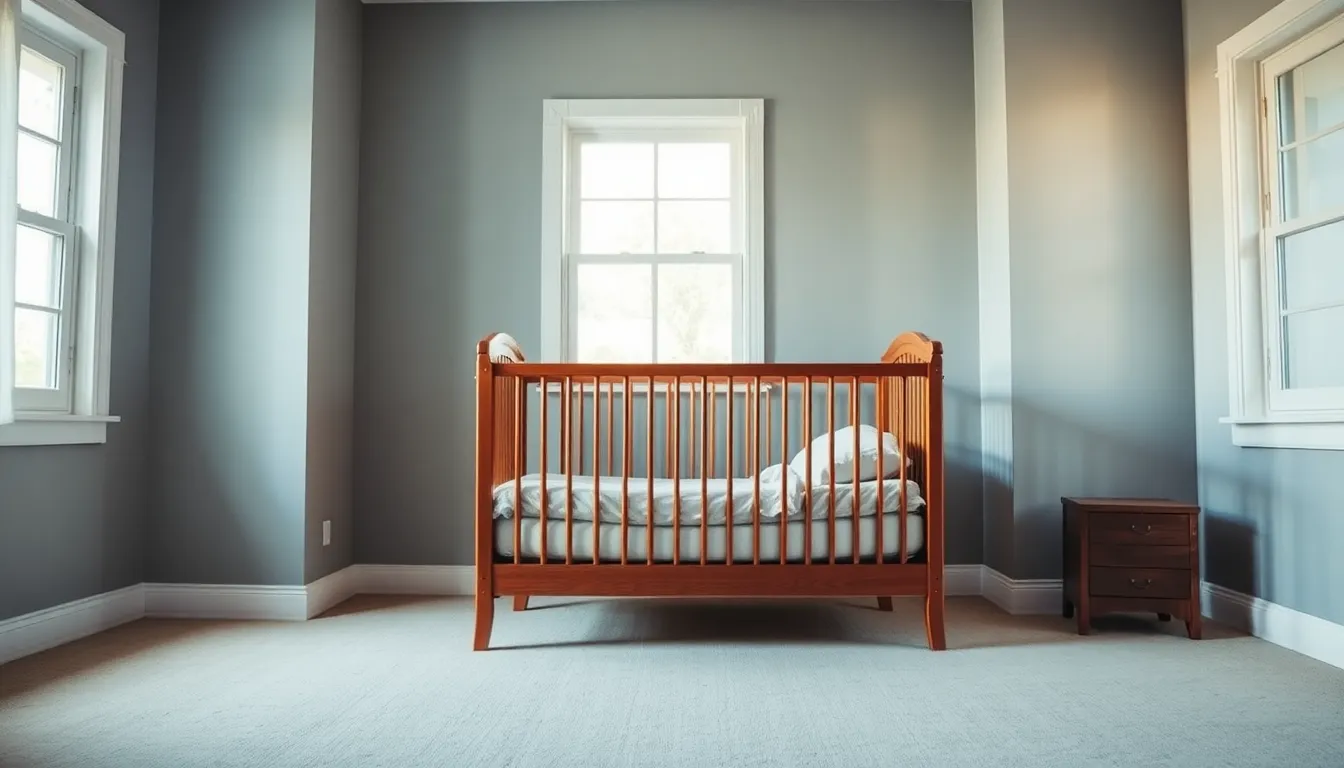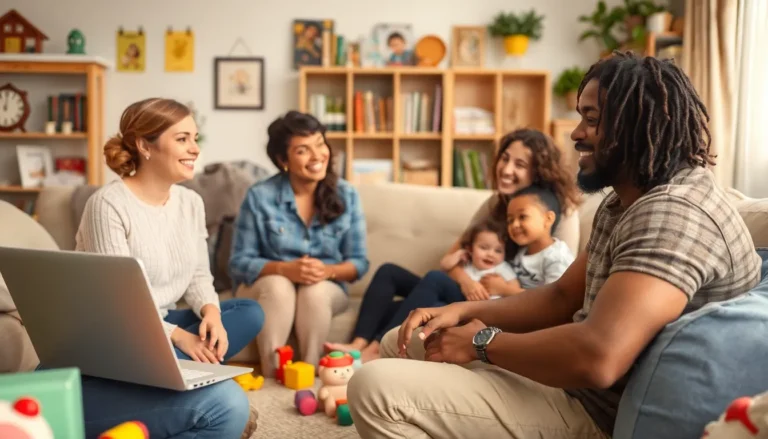Table of Contents
ToggleEvery parent knows that raising an infant is like navigating a minefield—one wrong step and kaboom! From diaper disasters to the infamous “why is my baby crying?” conundrum, the challenges are never-ending. But amidst the chaos, one thing is crystal clear: infant safety is non-negotiable. It’s not just about keeping the little ones from turning into tiny Houdinis; it’s about creating a secure environment where they can explore the world without turning it upside down.
Understanding Infant Safety
Infant safety is crucial for parents aiming to create a secure and nurturing environment. Ensuring a baby’s safety involves awareness of common risks and preventive measures.
Importance of Infant Safety
Creating a safe environment protects infants from harm. Parents and caregivers can foster exploration by eliminating hazards. According to the American Academy of Pediatrics, safe sleep practices reduce the risk of sudden infant death syndrome (SIDS) significantly. Regularly checking toys and cribs ensures they meet safety standards, minimizing dangers. Awareness of fire safety, poison control, and fall prevention further reinforces a child’s safety at home. Education regarding infant CPR can also be invaluable, equipping caregivers with skills to respond in emergencies.
Common Risks for Infants
Infants face various risks, highlighted by their natural curiosity. Choking hazards are prevalent, with small objects and food posing significant threats. Falls occur frequently as babies begin to crawl and explore their surroundings. Additionally, improper car seat use increases the risk of injury in accidents. Exposure to harmful substances, such as cleaning supplies and medications, can lead to serious health issues. Experts recommend keeping these items out of reach and using safety locks on cabinets. Identifying and addressing these risks safeguards infants and supports their healthy development.
Safe Sleeping Practices

Safe sleeping practices play a vital role in infant safety, significantly reducing the risk of sudden infant death syndrome (SIDS) and other hazards.
Crib Safety Guidelines
Cribs must meet safety standards set by the Consumer Product Safety Commission. Ensure the crib has a firm mattress that fits snugly without gaps. Check for any loose or broken parts, including slats, and verify that the crib’s slats are no more than 2.375 inches apart to prevent entrapment. Keep the crib free from pillows, blankets, and stuffed animals, which pose suffocation risks. Position the crib away from windows, cords, and blinds to eliminate potential hazards. Regular inspections of the crib and all associated equipment help maintain a secure sleeping environment.
Co-Sleeping Risks
Co-sleeping increases the risk of suffocation and falls, presenting dangers that many families may overlook. Sharing a bed can create a situation where a parent accidentally rolls over onto the infant. Soft bedding, such as comforters and pillows, further elevates suffocation risks for babies. Instead of co-sleeping, consider using a bassinet or crib placed close to the parent’s bed. Maintaining a separate sleep space allows for safe monitoring while minimizing risks. Make informed decisions regarding sleep arrangements to prioritize the infant’s well-being during the night.
Car Seat Safety
Car seat safety is crucial for protecting infants during travel. Understanding how to choose and install a car seat enhances the safety of young ones.
Choosing the Right Car Seat
Selecting the appropriate car seat involves several key considerations. First, parents must match the car seat with their child’s age, weight, and height. Infant car seats provide rear-facing support, essential for newborns and small infants. Convertible car seats serve multiple stages, transitioning from rear to forward-facing as the child grows. Additionally, ensuring the car seat complies with the Federal Motor Vehicle Safety Standards guarantees a higher safety level. Parents should also consider features like side-impact protection, adjustable harness systems, and a base for easier installation. Choosing a seat that’s easy to use encourages consistent safety practices.
Installation Tips for Safety
Proper installation of a car seat significantly affects its effectiveness. Start by reading both the car seat and vehicle owner’s manuals. Most recommend placing the car seat in the rear seat, as it offers better protection. Check that the car seat is tightly secured; it should not move more than an inch side to side. Use either the vehicle’s seat belt or the LATCH system for secure attachment. The harness straps should rest snugly against the child’s shoulders for optimal safety. When the seat is rear-facing, the incline angle must comply with the manufacturer’s guidelines to ensure comfort and safety. Regularly checking the car seat whenever it’s moved or adjusted helps maintain safety standards.
Baby Proofing Your Home
Creating a safe space for an infant involves proactive measures throughout the home. Baby proofing ensures that every room minimizes hazards and promotes exploration without unnecessary risks.
Rooms to Focus On
Kitchens often pose significant dangers. Unsecured cabinets can contain harmful substances, so using safety latches is essential. Living rooms require attention as well. Furniture with sharp edges should have corner protectors applied. Bathrooms are another high-risk area. Toilet locks and non-slip mats help prevent accidents. Bedrooms also need consideration, particularly with cribs placed away from windows and cords. Stairs should have sturdy gates installed at both the top and bottom. Prioritizing these key areas ensures infants explore safely.
Essential Baby Proofing Products
Safety latches provide security for cabinets and drawers. Investing in corner guards protects little ones from sharp furniture edges. Outlet covers prevent accidental shocks from electrical outlets. Safety gates create barriers in high-risk areas. Anti-tip furniture anchors stabilize heavy items, reducing the risk of tipping over. Non-slip mats add traction in slippery spaces. Crib safety devices ensure sleep surfaces remain secure. Choosing these essential products enhances safety and supports healthy development.
Health and Wellness Considerations
Maintaining an infant’s health and wellness involves attentive monitoring and preventive measures. Parents can ensure their child receives appropriate medical care through regular check-ups and vaccinations.
Vaccinations and Check-Ups
Vaccinations play a critical role in protecting infants from serious illnesses. The Centers for Disease Control and Prevention recommend that infants receive vaccinations according to the recommended immunization schedule. Regular well-child check-ups allow healthcare providers to assess growth and development while addressing concerns about milestones. These visits also offer parents valuable information about nutrition and safety. Keeping up with vaccinations and check-ups ensures infants have a strong foundation for health and wellness.
Recognizing Hazards in the Environment
Recognizing potential hazards in the environment ensures safer exploration for infants. Common risks may include sharp objects, choking hazards, or toxic substances. Parents should inspect every room, looking for unsafe items within reach, and remove potential dangers. Basic safety measures, like securing furniture to walls, prevent tipping accidents. Regularly checking that safety gates are functional keeps infants safe on stairs. Awareness of these hazards supports a secure environment where infants can thrive and explore their surroundings.
Ensuring infant safety is a fundamental responsibility for every caregiver. By implementing proactive measures and staying informed about potential hazards, parents can create a nurturing environment that supports their child’s exploration and development. Regularly checking safety standards for cribs and car seats, practicing safe sleep guidelines, and baby proofing the home are essential steps in safeguarding infants.
Moreover, maintaining awareness of health and wellness through regular check-ups and vaccinations plays a crucial role in protecting against serious illnesses. By prioritizing these safety practices, caregivers can foster a secure space where infants can thrive and grow confidently.



